Kvescio Week 2 Assignment
Weekly Assignments
- user:kvescio ~ Instructions: BIOL368/S20:Week 1
- kvescio Week 2 Assignment ~ Instructions: BIOL368/S20:Week 2
- kvescio Week 3 Assignment ~ Instructions: BIOL368/S20:Week 3
- kvescio Week 4 Assignment ~ Instructions: BIOL368/S20:Week 4
- kvescio Week 5 Assignment ~ Instructions: BIOL368/S20:Week 5
- kvescio Week 6 Assignment ~ Instructions: BIOL368/S20:Week 6
- kvescio Week 8 Assignment ~ Instructions: BIOL368/S20:Week 8
- kvescio Week 10 Assignment ~ Instructions: BIOL368/S20:Week 10
- kvescio Week 11 Assignment ~ Instructions: BIOL368/S20:Week 11
- kvescio Week 13 Assignment ~ Instructions: BIOL368/S20:Week 13
- kvescio Week 14 Assignment ~ Instructions: BIOL368/S20:Week 14
Class Journals
- BIOL368/S20:Class Journal Week 1
- BIOL368/S20:Class Journal Week 2
- BIOL368/S20:Class Journal Week 3
- BIOL368/S20:Class Journal Week 4
- BIOL368/S20:Class Journal Week 5
- BIOL368/S20:Class Journal Week 6
- BIOL368/S20:Class Journal Week 10
- BIOL368/S20:Class Journal Week 11
- BIOL368/S20:Class Journal Week 13
- BIOL368/S20:Class Journal Week 14
Purpose
The purpose of this assignment was to determine the differences in DNA sequence of alleles, determine how the DNA sequence of a pigment protein gene determines the color of the protein, understand why some color phenotypes are dominant and some are recessive, and lastly, to construct a true-breeding purple flower.
Notes from Class
- Difference between yellow and red at 79,80
- Difference between white and blue at 78,79
- Difference between white and yellow at 79,80
- Difference between blue and green at 83 (T vs. G)
- Difference between yellow and green at 79,80,83
- Difference between red and blue at 79
- Difference between green and red at 79,83
- Difference between red and white at 7
- Difference between blue and yellow at 79,80
- Difference between red and yellow at 79,80
- White to yellow 78 (G>T), 79 (T>G), 80 (C>G)
- Red to white 78 (G>T)
- White to green 79 (T>A), 83 (T>G), 78 (G>T)
- Blue to white 78 (G>T), 79 (T>A).
- Black mutant of Green-1 by changing Green to Red and breeding Red and Green together.
Combined Methods and Results
Methods
- . Launch Aipotu on computer. [Aipotu]
- . Switch to the "Molecular Biology" tab
- . Read over background information and instructions in packet.
Specific Tasks for Molecular Biology
a.) What are the differences in the DNA sequences of the alleles you defined in Part 1?
- The alleles from Part 1 were red, green, blue, yellow, and white. After breeding the alleles with each other, it was discovered that white was the only one that was always recessive.
- Refer to Table A for differences in DNA sequences.
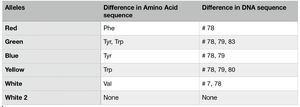
b.) Do all the white alleles have the same DNA sequence?
- By using the "Compare" menu to compare the different white sequences, we discovered that not all of the white sequences were the same. The compare menu showed that they were different at position 7 and 78. One of the white organisms was created by deletion in a red flower. The white organism is lack of color, rather than a specific allele. Therefore, not all white organisms will have the same sequence.
c.) Which DNA sequences are found in each of the four starting organisms?
- Green-1
CAGCTATAACCGAGATTGATGTCTAGTGCGATAAGCCCCAAAGATCGGCACATTTTGTGCGCTATACAAAGGTTAGTGTACTGGCGGCAGTAGTAGGGGGCGT
- Green-2
CAGCTATAACCGAGATTGATGTCTAGTGCGATAAGCCCCAAAGATCGGCACATTTTGTGCGCTATACAAAGGTTAGTGTACTGTCGGCAGTAGTAGGGGGCGT CAGCTATAACCGAGATTGATGTCTAGTGCGATAAGCCCCAAAGATCGGCACATTTTGTGCGCTATACAAAGGTTAGTGTGGTGTCGGCAGTAGTAGGGGGCGT
- Red
CAGCTATAACCGAGATTGATGTCTAGTGCGATAAGCCCCAAAGATCGGCACATTTTGTGCGCTATACAAAGGTTAGTGTTCTGTCGGCAGTAGTAGGGGGCGT CAGCTATGACCGAGATTGATGTCTAGTGCGATAAGCCCCAAAGATCGGCACATTTTGTGCGCTATACAAAGGTTAGTGTTCTGTCGGCAGTAGTAGGGGGCGT
- White-1
CAGCTATAACCGAGATTGATGTCTAGTGCGATAAGCCCCAAAGATCGGCACATTTTGTGCGCTATACAAAGGTTAGTGGTCTGTCGGCAGTAGTAGGGGGCGT
- White-2
CAGCTATAACCGAGATTGATGTCTAGTGCGATAAGCCCCAAAGATCGGCACATTTTGTGCGCTATACAAAGGTTAGTGGTCTGTCGGCAGTAGTAGGGGGCGT
d.) Pure-bred purple organism
- My lab partners and I tried several times to make a pure-breeding purple organism. We could only get a purple gene when we mixed two colors together. We bred the blue and red organisms together and the resulting progeny was purple. However, we could not access the DNA sequence for this organism, and we realized that it was not pure-bred.
- We thought about how we could make it a pure-bred purple organism. We came to the conclusion that we could change the yellow gene in the Green-2 organism to a red gene.
- We did this by first, comparing red and yellow and seeing where their sequences were different.
- We discovered that red and yellow differed at 79 and 80 in their sequence.
- We changed 79 to T and 80 to C to change the gene from yellow to red.
- Then, we bred the true blue and red gene together to get purple phenotype.
- Refer to Image Purple 1
- The resulting progeny was still not a pure-bred purple.
- We looked at the sequence of the purple gene and decided to change the red to purple.
- We combined the two genes together by placing a Tyr before the Phe in the red gene sequence.
- Refer to Image Purple 2
- This resulted in a pure-bred purple organism.
- Refer to Image Purple 3 to see DNA of pure-bred purple organism.
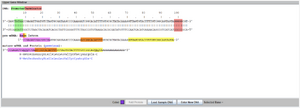
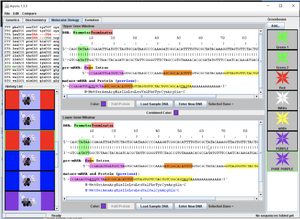
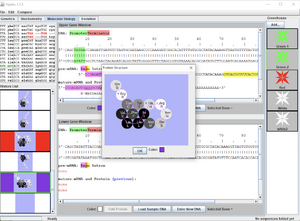
e.) How does the DNA sequence of the different alleles explain the effects of mutations you found in part I?
- In Part 1, the Genetics group discovered a black mutant of Green-1 by changing Green to Red, and then breeding Red and Green together. They also discovered an orange mutant.
- Changing the DNA, or amino acid sequence of different alleles creates mutant organisms.
f.) Try making this protein: MLVKEIAMYRFATHER
- I made this protein by using the genetic code to write a sequence. I manually typed in the nucleotide sequence.
- I referred to the Genetic Code in mRNA table provided for me.
- My resulting protein was the one provided in Image F.
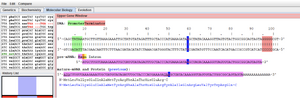
Data and Files
Conclusion
The purpose of this experiment was ultimately to be able to understand how to use [Aipotu], how to find differences in DNA sequences of alleles, how to determine which alleles were dominant and which were recessive, and finally, to create a pure-bred organism. I learned how to compare different alleles regarding their amino acid and DNA sequences. By comparing two alleles, I could see where they differed. After collecting data from where all the positions were different, I concluded that white was the only gene that was completely recessive. Afterwards, my team members and I went on to create a pure-breeding purple flower. Some trial and error was necessary until we learned that we could change the yellow gene to a red one, and breed it with the blue gene. This made a purple flower. Then we changed the Amino Acid sequence of the red gene, and got another purple flower. After breeding those two purple flowers, we got a pure-bred purple organism.
Acknowledgements
- I worked with my partners Nathan On and Madeleine King during class, and shared information via Google Docs.
- My partners Nathan On, Madeleine King, and I shared Images with each other via Google Docs. Used the same images for pure-bred purple flower, and MLVKEIAMYRFATHER protein.
- I texted Lizzy Urbina with a question concerning formatting.
- Lizzy Urbina showed me how to format a picture.
- I looked over Madeleine King's individual journal for formatting.
- I downloaded and used [Aipotu] for this assignment
- I went to the Week 1 page in order upload images.
- Except for what is noted above, this individual journal entry was completed by me and not copied from another source.
Kvescio (talk) 19:43, 29 January 2020 (PST)
References
- OpenWetWare. (2020). BIOL368/S20:Week 2. Retrieved January 28, 2020, from https://openwetware.org/wiki/BIOL368/S20:Week_2
- Aipotu. (2017). Aitopu. Retrieved January 25, 2020, from http://aipotu.umb.edu/
- Aipotu. (2017). Aipotu Part III: Molecular Biology. Retrieved January 25, 2020, from http://aipotu.umb.edu/docs/AipotuIII.pdf